For many potential homeowners, purchasing a house in a peaceful rural community is a cherished American dream. Yet, the financial hurdles can make it seem unattainable. This is where the USDA rural development loan, a lesser-known mortgage offering by the United States Department of Agriculture, becomes a beacon of hope.
The program aims to bolster the economy and elevate the quality of life in rural areas through affordable homeownership opportunities. With advantages like zero down payment, reduced interest rates, and lenient credit requirements, these loans can be the key to unlocking the door to your new home.
What is a USDA Rural Development Loan?
A USDA rural development loan stands out in the mortgage landscape, specifically designed to support aspiring homeowners looking to settle in rural locales. This government-backed loan bears the mission of fostering rural prosperity by providing access to more attainable homeownership under these key benefits:
- No down payment requirements.
- Competitive interest rates below the market average.
- Flexible credit score guidelines.
What’s more, eligibility thresholds prioritise households with moderate incomes, thereby contributing to sustainable community development. To obtain this loan:
- An individual’s income must align with delineated limitations.
- The property must be nestled within an area sanctioned by the USDA.
Ideal for first-time buyers and those with modest earnings, the USDA loan lightens the financial load, making the leap into homeownership feasible and less intimidating.
Who is Eligible for a USDA Rural Development Loan?
Eligibility for a USDA rural development loan is crucial for interested parties aiming to take advantage of this unique home-buying route. Here’s who qualifies:
- Seekers of homes in USDA-defined rural territories.
- Households earning at or below designated income brackets based on location.
- Citizens or legal residents of the U.S., committed to inhabiting the property as their main residence.
Credit-wise, this program diverges from the stringent norms of conventional loans due to its more accommodating stance. Nevertheless, applicants must exhibit responsible credit behaviour and the means to repay the loan. The home should also abide by USDA guidelines, ensuring it is a safe and sound investment.
Usda Rural Development Loan Requirements
To be eligible for a USDA Rural Development loan, applicants must meet certain criteria that are primarily focused on income and property location. For example, the USDA requires that the applicant’s income not exceed 115% of the median income for the area.
Furthermore, the property in question must be located within an eligible rural area as designated by the USDA. Potential borrowers need to understand that the USDA Rural Development loan program seeks to enhance the economic well-being and quality of life for rural Americans.
Therefore, the program has specific credit requirements, which include a dependable income history and a credit score that reflects an ability to manage debt.
Additionally, the USDA mandates that the home being purchased must serve as the applicant’s primary residence and be in a condition that meets the USDA’s standards for habitability.
For more detailed information on these requirements, prospective buyers can check the USDA’s official website or consult a mortgage lender specializing in USDA loans.
It’s important to note that there are different types of USDA loans, such as the Single Family Housing Guaranteed Loan Program and the Single Family Housing Direct Home Loans, each with their nuances, so understanding the particulars of the desired program is key to a successful application.
USDA Rural Development Loan Map
The USDA loan program is specifically designed to encourage homeownership and economic development in less-dense communities across the United States. To be eligible for this beneficial program, a property must be located within an area designated as ‘rural’ by the USDA.
Fortunately, potential homebuyers can easily check property eligibility via the USDA’s online eligibility map. This interactive tool allows users to input the address of the property they are interested in, providing instant feedback on whether it falls within an eligible area.
Despite the program’s name, many potential homebuyers are surprised that many suburban areas just outside city limits qualify as ‘rural’ according to USDA standards.
This opens up avenues for homeownership with no down payment requirements to a wider audience, making the dream of owning a home more accessible and affordable, especially for first-time buyers.
Before setting your heart on a property, however, consult the current USDA Rural Development Loan Map and verify the eligibility status, as the designations can change annually based on census data and rural development goals.
What Types of Properties Qualify for USDA Rural Development Loans?
USDA loans are not one-size-fits-all; they are precise in the property types they encompass. Suitable properties are:
- Homes within the boundaries of rural development as mapped out by the USDA.
- Single-family residences, approved condos, and modular homes fit USDA criteria.
- Dwellings serving as the principal abode of the borrower.
Although multi-family units (up to four) can be eligible, this is conditioned upon the buyer residing in one of the units. Properties like farms or commercial enterprises don’t align with the program’s vision and are thus excluded from eligibility.
Are There Any Income Limits for Applicants of USDA Rural Development Loans?
USDA loans serve a specific demographic — those with low-to-moderate incomes desiring to root themselves in rural settings. The income ceiling:
- Fluctuates by location, reflecting the median income and household size dynamics.
- Typically caps at 115% of a region’s median income, upholding the ethos of the program.
Staying true to the ever-evolving economic landscape, these limits are under constant review, anchored by the agency’s commitment to maintain accessibility to its core audience.
How Do I Apply for a USDA Rural Development Loan and What is the Process?
The application journey for a USDA rural development loan heralds a new beginning and progresses as follows:
- Validate your credentials by exploring income, locale, and credit prerequisites through official USDA channels or authorized lenders.
- Pinpoint a USDA-endorsed lender; they will guide you from pre-approval to the final milestone.
- Assemble essential documents such as income affirmation, job records, and more to facilitate the lender’s evaluation.
- Tackle the loan application, infusing accuracy and thoroughness to speed along the process.
- After submission, patience is key as your application is scrutinized, followed by property assessment, culminating in the loan closeout, signalling the start of new horizons.
Embarking on a USDA rural development loan can be transformative, especially with tailored guidance from financial experts and diligent preparation.
These loans stand as a testament to the government’s commitment to bolster rural community growth through the power of homeownership. For many, it’s not just a loan but a passage to life amidst the tranquil tapestry of rural America—attainable, sustainable, and within reach.






